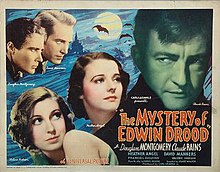The Mystery of Edwin Drood (1935 film)
| The Mystery of Edwin Drood | |
|---|---|
 | |
| Directed by | Stuart Walker |
| Screenplay by |
|
| Based on | The Mystery of Edwin Drood by Charles Dickens |
| Produced by | Carl Laemmle, Jr.[1] |
| Starring | |
| Cinematography | George Robinson[1] |
| Edited by | Edward Curtiss[1] |
| Music by | Edward Ward[1] |
Production company | |
| Distributed by | Universal Pictures Corp. |
Release date |
|
Running time | 87 minutes[1] |
| Country | United States[2] |
| Language | English |
| Budget | $215,375 |
The Mystery of Edwin Drood is a 1935 American melodrama directed by Stuart Walker. The film is based on the unfinished 1870 novel The Mystery of Edwin Drood by Charles Dickens.[1]
Cast[]

- Claude Rains as John Jasper
- David Manners as Edwin Drood
- Heather Angel as Rosa Bud
- Valerie Hobson as Helna Landless
- E.E. Clive as Mayor Sapsea
- Francis L. Sullivan as The Rev. Mister Crisparkle
- Douglass Montgomery as Neville Landless
- Walter Kingsford as Mr. Grewgious
- Zeffie Tilbury as Princess Puffer
- J.M. Kerrigan as Chief Verger Tope
- Walter Brennan as Milk Man
- Harry Cording as Turke (uncredited)
Style[]
In the book Universal Horrors, the authors described the film as "neither an all-out horror story nor a puzzling whodunnit," stating the film would be easier placed in contemporary terms as "a quaintly charming and atmospheric Victorian melodrama" and lacking in real suspense.[3]
Production[]
Universal Pictures Corp. was enthusiastic about adapting The Mystery of Edwin Drood and exploiting its lack of finale. Universal gave the film high production values of $215,375 and developed an aggressive advertising campaign to exploit the novel's unresolved ending.[3] According to Universal publicity, the studio's London office shot thousands of feet of film and took numerous still shots of Victorian-style structures in Rochester in 1934, for the film.[4] A large set was built in Universal's back lot and was the largest set built for Universal since The Hunchback of Notre Dame.[4] The film's shooting was delayed initially due to casting difficulties. Production began on the film, November 12, 1934 and continued until January 1935.[5]
Among the cast was David Manners as Edwin Drood.[1] It was Manners' last film.[6] Manners spoke later in life that he " Didn't like movies. You see, in a play you become the play, because you start in the beginning and end up at the end of the script. Movies, you do little bits and you don't know where it fits in.... It has no unity."[7] When asked about The Mystery of Edwin Drood, Manners responded that " ... it was not a good movie at all."[7]
Release[]
The Mystery of Edwin Drood was distributed by Universal Pictures Corp. on February 4, 1935.[1][2]
Reception[]
In the book Universal Horrors, the authors described contemporary critical reception as winning "the approval of most film critics of the time."[3] William Boehnel of The New York World-Telegram declared the film "a thoroughly entertaining, exciting and atmospherically fine screen version of the novel."[7] Eileen Creelman of the New York Sun declared it "a gruesome melodrama with enough action and background mystery to make it go."[7] Bland Johaneson of the New York Daily Mirror declared the film "handsomely produced and acted" and that it would hold audiences in "complete interest".[7]
Andre Sennwald of The New York Times declared that the films "combination of adroit direction and acting isn't strong enough to overcome an essentially weak narrative."[7] In the United Kingdom, Kinematograph Weekly said that "Individual acting is very good, and the atmosphere is faithful in detail, but neither can invest the story development with strong suspense nor preserve its secret" concluding that "There is no denying that Claude Rains is a brilliant actor, this does not prevent his mannerisms and inflections from becoming a trifle monotonous."[7]
From retrospective reviews, Craig Butler of AllMovie stated that "the film's screenplay, which is too often predictable and too seldom surprising." and that Stuart Walker had directed the film "efficiently and with a touch of flair here and there; it's not outstanding work".[8] Butler concluded that "Where Drood shines is in its cast, led by a typically marvelous Claude Rains, who conveys the lust, shame, desperation, and determination of his character with aplomb. Douglass Montgomery is quite good in a dual role, and Heather Angel is appropriately lovely and timid. E.E. Clive and Zeffie Tilbury also are impressive in supporting roles," while concluding that the film "may not be a great film, but the actors make it decent entertainment."[8]
References[]
Footnotes[]
- ^ a b c d e f g h i Weaver, Brunas & Brunas 2007, p. 110.
- ^ a b c "Mystery of Edwin Drood". American Film Institute. Retrieved May 1, 2020.
- ^ a b c Weaver, Brunas & Brunas 2007, p. 111.
- ^ a b Weaver, Brunas & Brunas 2007, p. 112.
- ^ Weaver, Brunas & Brunas 2007, p. 113.
- ^ Weaver, Brunas & Brunas 2007, p. 114.
- ^ a b c d e f g Weaver, Brunas & Brunas 2007, p. 115.
- ^ a b Butler.
Sources[]
- Butler, Craig. "The Mystery of Edwin Drood". AllMovie. Retrieved May 1, 2020.
- Weaver, Tom; Brunas, Michael; Brunas, John (2007) [1990]. Universal Horrors (2 ed.). McFarland & Company. ISBN 978-0-7864-2974-5.
External links[]
| Wikiquote has quotations related to: The Mystery of Edwin Drood (1935 film) |
- 1935 films
- English-language films
- American films
- American historical films
- American black-and-white films
- Films directed by Stuart Walker
- Films scored by Edward Ward (composer)
- Universal Pictures films
- 1930s historical films
- Films based on works by Charles Dickens
- Films set in the 19th century
- Melodramas